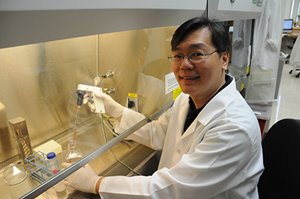Dr. Hsu to Continue Stem Cell Research with $2.5 Million Grant
Wei Hsu, Ph.D., dean’s professor of Biomedical Genetics in the Center for Oral Biology and a scientist with the Eastman Institute for Oral Health at the University of Rochester Medical Center, received a $2.5 million, five year grant to continue his groundbreaking work involving the role of stem cells in tissue regeneration and reconstructive surgical repair.
 Currently, the only solution for extensive large bone defects caused by cancer surgery, congenital malformation, trauma and progressive deforming diseases, is to undergo a reconstructive operation. For the 2.2 million cases a year around the world conducted in orthopedic, plastic and oral surgeries, these operations usually involve autografts that require transferring bones from other parts of the body.
Currently, the only solution for extensive large bone defects caused by cancer surgery, congenital malformation, trauma and progressive deforming diseases, is to undergo a reconstructive operation. For the 2.2 million cases a year around the world conducted in orthopedic, plastic and oral surgeries, these operations usually involve autografts that require transferring bones from other parts of the body.
“However, bone grafts are encumbered by numerous disadvantages, including donor site morbidity, limited bone supply and complications of extended operating time,” Dr. Hsu explained. “The success of such reconstructions also remains highly challenging due to several limitations.”
Through the years, scientists have explored alternative approaches, especially stem cell-based therapy, but the lack of knowledge regarding stem cells specifically for craniofacial skeletogenesis has greatly restricted further advancement.
The grant, titled Stem Cells for Craniofacial Bone Repair and Regeneration, is funded by the National Institute of Dental and Craniofacial Research, part of National Institutes of Health, will further explore the use of stem cells in reconstructive surgical repair.
 Using state-of-the-art mouse genetic models from Dr. Hsu’s 2016 work that successfully identified and isolated a novel stem cell population from the craniofacial skeleton, Dr. Hsu and Takamitsu Maruyama, Ph.D., research assistant professor of Dentistry and co-investigator for the grant, will now study how these stem cells are regulated to control normal formation and maintenance of the mouse skull.
Using state-of-the-art mouse genetic models from Dr. Hsu’s 2016 work that successfully identified and isolated a novel stem cell population from the craniofacial skeleton, Dr. Hsu and Takamitsu Maruyama, Ph.D., research assistant professor of Dentistry and co-investigator for the grant, will now study how these stem cells are regulated to control normal formation and maintenance of the mouse skull.
“We also want to understand how to maintain the stem cells’ undifferentiated state, how to expand their numbers, and how to control their ability to make bone or cartilage cells in the petri dish,” Dr. Hsu said. “Then, we’ll aim to examine the therapeutic potential of these stem cells. We hope the completion of this project will advance the field of regenerative medicine and move closer to clinical applications using stem cell-based therapy.”

